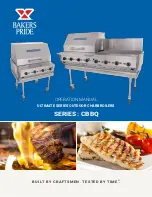
48
Maintenance as outlined below can be performed by the
owner unless otherwise noted.
The acidic nature of flue gasses condensing on the aluminum
boiler sections will cause the formation of aluminum oxide.
This oxide formation is normal, is generally uniform through-
out the boiler sections, and represents a negligible mass of
aluminum that is consumed by oxidation during the life of
the boiler. If left unchecked, this buildup may eventually cause
blockage of the flue gas passages in the boiler sections, reduc-
ing efficiency, and ultimately shutting down the boiler due to
lack of combustion air flow. Regular service and maintenance
by a qualified service agency must be performed to assure safe
trouble free operation and maximum efficiency.
Beginning Of Each Heating Season
Annual service call by a qualified service agency, which
1.
includes:
Examine flue passages between boiler sections, burner,
A.
and condensate lines, and clean if necessary following
the annual examination and cleaning instructions in para
graph “F” on the next page.
Visually inspect venting and air intake system for proper
B.
function, deterioration or leakage. If the vent or air intake
show any signs of deterioration or leakage, repair or
replace them, immediately. Insure proper reassembly and
resealing of the vent and air intake system
Check for and remove any obstruction to the flow of
C.
combustion air or venting of flue gases. Check the air
baffle located inside 1½” x 2” flexible coupling on the
mixer, clean it if necessary and make sure to put it back.
Refer to repair parts diagram of mixer and pressure
switch assembly for exact location.
Follow instructions for “PLACING BOILER IN OPERA-
D.
TION”.
Follow instructions for” CHECK OUT PROCEDURE
E.
AND ADJUSTMENTS”.
Visually inspect condensate drain line for proper opera-
F.
tion and deterioration. Check for plugged condensate
drain line.
Check the silicone rubber seals between boiler sections.
G.
Insure that there are no leaks. Use RTV silicone rubber
adhesive sealant (available in caulking gun tubes) rated
for at least 400° F to replace or repair seals in locations
where original seals have deteriorated.
Check all gasketed joints for leakage, and tighten bolts or
H.
replace gaskets if necessary.
Remove jacket front and top panels and check for pip-
I.
ing leaks around relief valve and other fittings. Repair, if
found. DO NOT use stop leak compounds.
Check that boiler area is free from combustible materials,
2.
gasoline, and other flammable vapors and liquids.
Circulator pump and blower motor furnished with boiler
3.
are permanently lubricated from factory and require no
further lubrication. Additional or non-factory supplied
pumps and/or motors should be lubricated according to
the pump and/or motor manufacturer’s instruction.
Daily During Heating Season
Check for and remove any obstruction to the flow of com-
1.
bustion air or venting of flue gases.
Check that boiler area is free from combustible materials,
2.
gasoline, and other flammable vapors and liquids.
MAINTANANCE AND CLEANING
Summary of Contents for UB100
Page 15: ...15 Near Boiler Piping Figure 2 Single Zone Boiler Piping ...
Page 16: ...16 Figure 3 Multi zone Boiler Piping With Zone Valves Near Boiler Piping ...
Page 19: ...19 Figure 6 Diaphragm Type Expansion Tank Piping Near Boiler Piping ...
Page 20: ...20 Figure 7 Conventional closed type Expansion Tank Piping Near Boiler Piping ...
Page 27: ...27 Combustion Air and Vent Pipe Figure 11 Combustion Air and Vent Piping ...
Page 32: ...32 Electrical Wiring Figure 13 Field Wiring Connections ...
Page 53: ...53 DETAILED SEQUENCE OF OPERATION ...
Page 57: ...57 TROUBLESHOOTING CHART 2 TROUBLESHOOTING ...
Page 58: ...58 TROUBLESHOOTING CHART 3 TROUBLESHOOTING ...
















































